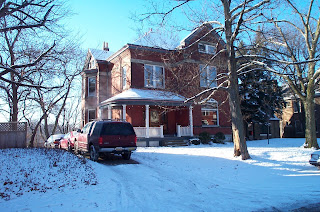 |
| Clifton Area of Cincinnati, OH |
If you
are going to be a successful liar, you need a great memory. Lies accumulate
over the years, and it takes more and more effort to keep them straight. By the
time I started writing the Seamus McCree novels, (Empty Promises is #5), my steel-trap mind was already suspect. I
reasoned that if I wrote using settings I knew, it was one less thing I had to
worry about remembering. Oh sure, I could have developed a detailed series
bible with all the invented places and so forth, but that’s a lot of work—and for
me, organization is more a wish than a reality. Since it’s easy to forget where
the closets are, I housed characters in residences I used to inhabit.
For Ant Farm and Bad Policy, I gave Seamus my house in the Clifton neighborhood of
Cincinnati (but moved it to another street). Uncle Mike, a continuing
character, resides in the apartment complex in Waltham, MA where I lived in
1978.
Cabin Fever is set in the Upper Peninsula
of Michigan where Seamus happens to have a camp located on the same lake where
I have my home. For Empty Promises, I
wanted to return to the U.P. and the story was willing. Our place—er Seamus’s
place—is fifteen miles from the nearest place you can buy anything. Fourteen of
those miles are gravel or dirt roads. Cabin
Fever was set in the dead of winter and in that story weather and the
gradual movement toward spring were their own character. Empty Promises occurs during summer, and although our place is not
as isolated as in winter, it is still remote, which is an important ingredient
in the story. And best of all, I don’t have to think about where the doors are
or which side of the house has the screened porch.
I’ll be
interested to hear in the comments how as readers y’all feel about using real
locations for novels. Do you enjoy reading about real places, or would you
prefer authors construct their own locations?
This blog was originally published as a guest post for part of the Empty Promises Virtual Book Tour.

I prefer real places. It seems to give it some authenticity, though maybe that's just because I can imagine you in Amassa.
ReplyDeleteIt's my preference as well both for places I know and to learn something about places I haven't yet visited.
DeleteI think, for reading, it doesn't matter to me if the places are real or not. If they are real, I am usually intrigued by them, sometimes looking them up :) As for writing, in most cases I keep the houses, hotels, or dwellings fictional, so there's no issue of verifying with the owner for use of the property. But I do have locales in my Southern Breezes stories that are real. They're set in Galveston and so some of the story lines touch on real settings :)
ReplyDeleteI understand there could be some potential legal ramification for using real places in fictional works. My personal rule is that I don't leave a body in a real place unless they are okay with that, and I don't diss a real restaurant, motel, etc. If the characters like the place, then I have no problem.
DeleteWith real people, if they are totally famous, I have no problem having a character refer to them. I'll check with real local personalities to makes sure they are okay with the mention or use of their persona.